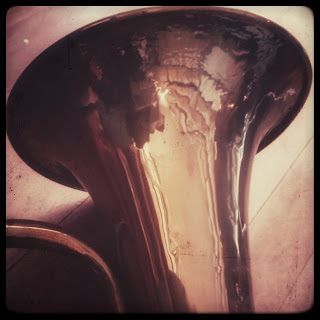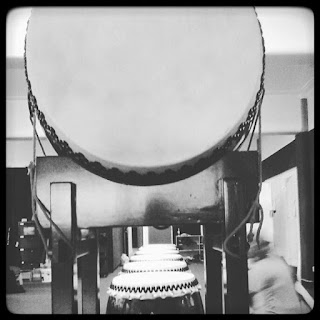One
disadvantage to group lessons is that it’s harder to cater individual students’
needs. I try to structure lessons so all
of the group are working at the same place in the book. If a student is struggling, they will
appreciate the extra time working on a particular song or concept, and if a
student can play the notes correctly, there are still more things they could be
working on or thinking about.
Monday, 30 May 2016
Friday, 27 May 2016
Group Lessons - What to Teach
What to
teach in a group lesson really depends on the level of the students. Beginners will spend more time on
fundamentals of technique and using the tutor book. More advanced students can work on their
ensemble playing skills.
Wednesday, 25 May 2016
Group Lessons - Structuring a Lesson
I have
outlined lesson structure in an earlier post, so this post is specifically
about structuring a lesson for a group class.
Monday, 23 May 2016
Group Lessons - Creating a Community
Learning
music in a group is such a fantastic way of becoming part of a community. For me, this is what music is about.
Friday, 20 May 2016
Group Lessons - Physical Set-Up
The next
few posts will be specifically about teaching groups. Group teaching requires different skills than
teaching 1-1. I love that group lessons
are social, and it’s easier to create that sense of community that the very
essence of music. Group lessons are
ideal for teaching ensemble skills and provide a ready-made audience for solo
playing.
Wednesday, 18 May 2016
The First Lesson
This is
one of my favourite moments in the teaching year – the very first lesson of a
beginner student.
They
turn up, all shiny and new. And the
instruments turn up all shiny and new.
This might be the first time you’ve met the student/s and the first time
they’ve met you. Greet them in a
friendly manner, ask their name (even if you already know it) and tell them
your name – it’s super important.
The
first lesson is where you start to get to know your students. Ask some personal questions – what school do
you go to is always a good one. If you
know another student or a teacher or have some other connection with that
school, mention it. It’s a good
ice-breaker and it shows that not only are you interested in the student, but
on some level your worlds intersect.
Ask them
why they want to play music, or your instrument in particular. What are their
goals? Do they already have experience
with music? Explain that while you get
to know what they can do or can’t do, you’ll be asking lots of questions. You might explain things that they already
know (and it’s ok for them to say that they know it) or you might not explain
things you think they know but don’t (again, tell them it’s ok to ask for
clarification).
Then it’s
time to get down to business. Hand out
instruments, or if they already have it, have them open the case (and teach
them how to open the case if it’s not obvious!). I start by just looking at the flute. I get the student to touch the keys and see
which key moves which other keys. I talk about the different parts of the flute
and we play a silly game to learn the names of the parts.
Every
instrument is different and your approach to the beginning of lessons will be
different for each instrument. With the
flute, certainly the first lesson is spent just using the headjoint getting a
clear, consistent sound. You will need
to think carefully about your instrument, and how to best begin.
The
first lesson is also a good time to talk about taking care of instruments and
where to store them at home.
Make
sure you assign some kind of homework on this lesson – they’ll be excited and
want to show off what they learned. Keep
it easy and manageable, but do let them know your expectations. I’ll tell kids they need to play their flute
to everyone who comes to their house during the week – mum, Grandpa, the cat,
even the plumber. Lucky plumber…!
Monday, 16 May 2016
Teaching in Someone Else’s Space
You may
have a gig teaching in a school or an after school programme, where you’re
actually in another teacher’s classroom.
Friday, 13 May 2016
Setting up a studio - what gear do you need?
Your
instrument. That’s pretty helpful
(although there have been occasions when my flute has had a little
unintentional holiday…). Really, it
depends on what you’re teaching, what style of music you teach, and your style
of teaching.
Wednesday, 11 May 2016
Setting up a studio
Now it’s
time to get going. You need to decide
where you’ll be teaching from. You may
have a space in your house, you may be able to use a space in a school or
similar, or you may want to rent a studio.
Monday, 9 May 2016
Friday, 6 May 2016
How to use a tutor book
Once you’ve decided on a book or
books, you need to think carefully about how to make the best use of it. Will you follow it slavishly, playing every
single song and every single exercise?
Will you spend the entire lesson playing from the book? Will you pick and choose – taking parts of
the book to serve the point of the lesson?
What you do is up to you, but at
the beginning of your teaching career I’d recommend following the book. The author will be an experienced
teacher/musician, and will have thought carefully about the order of
progression. The book will usually begin
with how to produce a sound on the instrument and posture. You don’t have to get through these pages in
the first lesson. With the flute, I
don’t usually put the instrument together until at least the second lesson
(maybe the third or fourth). I need to
be sure the student has got a good, consistent sound with just the headjoint,
otherwise, the rest of their playing will sound awful. During these first few lessons I spend the time
in between trying to get a sound by talking about practising, where to store
the flute, basic music theory (stave/crotchets etc), and how to NOT give your
flute to your little sister to play. Or
if something goes wrong to bring the flute to me. Dad is NOT allowed to touch it.
Sorry. Rant over.[1]
I use
the tutor book sparingly in the first 10 or so weeks of playing. It’s more important to establish good habits
in these weeks than it is to churn through pages of the book. Once you get going with the book, it’s
important to make sure the students understand each new concept. In a group lesson I will use a whiteboard to
explain things like time signatures and bars.
In a 1-1 lesson I write it directly in the students’ book. Do be thorough and don’t accept sloppy
playing.
If a
student doesn’t understand a concept, or can’t play the song independently, use
the song as a “study”. Take the
trickiest part of the song and break it down to its core components. Isolate rhythms or tricky fingerings. I don’t recommend moving on in the book until
the student can play the entire song independently. In group lessons this is hard to find a
balance. I’ll discuss this in another
post.
It can
be fun to go over easy songs in the book.
Once in a while (e.g. at the beginning or end of a term) the class and I
will play every song in the book until we can’t go any further. This is great because it means we can see how
far we’ve come (suddenly that “hard” song isn’t all that hard any more) and we
can consolidate all the learning so far.
Wednesday, 4 May 2016
Choosing a Tutor Book
Which
tutor book you use for beginners depends on a few things. If you are teaching through an established
programme, the book may have been decided upon by someone else. If you are teaching a particular method (e.g.
Suzuki) then you will use the materials designed for that style. However, if you are trying to decide on a
tutor book for private students you may want to take the following into
account.
Monday, 2 May 2016
What to Teach – Technique
Technique
is an important factor of playing any instrument. This should form a major part of your
lesson. Why? Because technique is the
foundation on which we build our playing.
Because every piece we are going to play is going to contain technical
elements and if you can isolate and perfect them, then playing the piece is
going to be a million times easier.
Subscribe to:
Comments (Atom)












